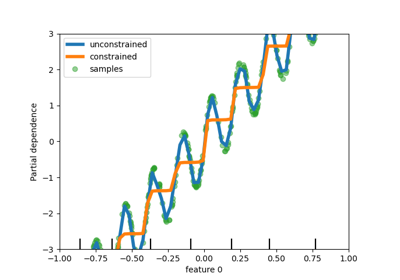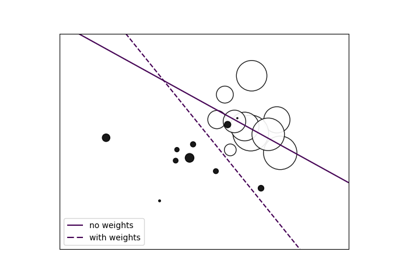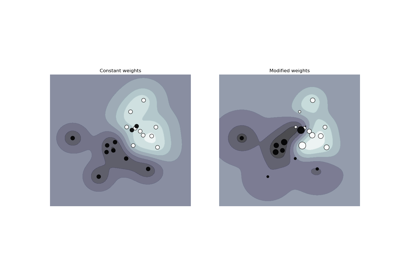注意
转到末尾以下载完整示例代码或通过 JupyterLite 或 Binder 在浏览器中运行此示例。
元数据路由#
本文档演示了如何使用 scikit-learn 中的元数据路由机制将元数据路由到使用它们的估计器、评分器和 CV 分割器。
为了更好地理解以下文档,我们需要引入两个概念:路由器(routers)和消费者(consumers)。路由器是一个将给定数据和元数据转发给其他对象的对象。在大多数情况下,路由器是一个元估计器(meta-estimator),即一个将另一个估计器作为参数的估计器。像sklearn.model_selection.cross_validate这样的函数,它接受一个估计器作为参数并转发数据和元数据,也是一个路由器。
另一方面,消费者是一个接受并使用给定元数据的对象。例如,一个在其fit方法中考虑sample_weight的估计器就是sample_weight的消费者。
一个对象既可以是路由器,也可以是消费者。例如,一个元估计器可能在某些计算中考虑sample_weight,但它也可能将其路由给底层估计器。
首先进行一些导入,并为脚本的其余部分准备一些随机数据。
# Authors: The scikit-learn developers
# SPDX-License-Identifier: BSD-3-Clause
import warnings
from pprint import pprint
import numpy as np
from sklearn import set_config
from sklearn.base import (
BaseEstimator,
ClassifierMixin,
MetaEstimatorMixin,
RegressorMixin,
TransformerMixin,
clone,
)
from sklearn.linear_model import LinearRegression
from sklearn.utils import metadata_routing
from sklearn.utils.metadata_routing import (
MetadataRouter,
MethodMapping,
get_routing_for_object,
process_routing,
)
from sklearn.utils.validation import check_is_fitted
n_samples, n_features = 100, 4
rng = np.random.RandomState(42)
X = rng.rand(n_samples, n_features)
y = rng.randint(0, 2, size=n_samples)
my_groups = rng.randint(0, 10, size=n_samples)
my_weights = rng.rand(n_samples)
my_other_weights = rng.rand(n_samples)
元数据路由仅在明确启用时才可用
set_config(enable_metadata_routing=True)
此实用函数是一个用于检查元数据是否已传递的虚拟函数
def check_metadata(obj, **kwargs):
for key, value in kwargs.items():
if value is not None:
print(
f"Received {key} of length = {len(value)} in {obj.__class__.__name__}."
)
else:
print(f"{key} is None in {obj.__class__.__name__}.")
一个用于清晰打印对象路由信息的实用函数
def print_routing(obj):
pprint(obj.get_metadata_routing()._serialize())
消费者估计器#
在这里,我们演示了估计器如何公开所需的 API 来支持元数据路由作为消费者。想象一个简单的分类器,在其fit方法中接受sample_weight作为元数据,在其predict方法中接受groups。
class ExampleClassifier(ClassifierMixin, BaseEstimator):
def fit(self, X, y, sample_weight=None):
check_metadata(self, sample_weight=sample_weight)
# all classifiers need to expose a classes_ attribute once they're fit.
self.classes_ = np.array([0, 1])
return self
def predict(self, X, groups=None):
check_metadata(self, groups=groups)
# return a constant value of 1, not a very smart classifier!
return np.ones(len(X))
上面的估计器现在具备了使用元数据所需的一切。这是通过BaseEstimator中的一些“魔法”完成的。上述类现在公开了三个方法:set_fit_request、set_predict_request和get_metadata_routing。还有一个针对sample_weight的set_score_request,它存在是因为ClassifierMixin实现了一个接受sample_weight的score方法。这同样适用于继承自RegressorMixin的回归器。
默认情况下,没有请求任何元数据,我们可以看到如下输出
print_routing(ExampleClassifier())
{'fit': {'sample_weight': None},
'predict': {'groups': None},
'score': {'sample_weight': None}}
上面的输出意味着ExampleClassifier没有请求sample_weight和groups,如果路由器给出了这些元数据,它应该引发错误,因为用户没有明确设置是否需要它们。对于score方法中的sample_weight也是如此,它继承自ClassifierMixin。为了明确设置这些元数据的请求值,我们可以使用这些方法
est = (
ExampleClassifier()
.set_fit_request(sample_weight=False)
.set_predict_request(groups=True)
.set_score_request(sample_weight=False)
)
print_routing(est)
{'fit': {'sample_weight': False},
'predict': {'groups': True},
'score': {'sample_weight': False}}
注意
请注意,只要上述估计器未在元估计器中使用,用户就不需要为元数据设置任何请求,并且设置的值将被忽略,因为消费者不会验证或路由给定的元数据。对上述估计器的简单使用将按预期工作。
est = ExampleClassifier()
est.fit(X, y, sample_weight=my_weights)
est.predict(X[:3, :], groups=my_groups)
Received sample_weight of length = 100 in ExampleClassifier.
Received groups of length = 100 in ExampleClassifier.
array([1., 1., 1.])
路由元估计器#
现在,我们展示如何设计一个元估计器作为路由器。作为一个简化的示例,这里有一个元估计器,除了路由元数据之外,它没有做太多其他事情。
class MetaClassifier(MetaEstimatorMixin, ClassifierMixin, BaseEstimator):
def __init__(self, estimator):
self.estimator = estimator
def get_metadata_routing(self):
# This method defines the routing for this meta-estimator.
# In order to do so, a `MetadataRouter` instance is created, and the
# routing is added to it. More explanations follow below.
router = MetadataRouter(owner=self).add(
estimator=self.estimator,
method_mapping=MethodMapping()
.add(caller="fit", callee="fit")
.add(caller="predict", callee="predict")
.add(caller="score", callee="score"),
)
return router
def fit(self, X, y, **fit_params):
# `get_routing_for_object` returns a copy of the `MetadataRouter`
# constructed by the above `get_metadata_routing` method, that is
# internally called.
request_router = get_routing_for_object(self)
# Meta-estimators are responsible for validating the given metadata.
# `method` refers to the parent's method, i.e. `fit` in this example.
request_router.validate_metadata(params=fit_params, method="fit")
# `MetadataRouter.route_params` maps the given metadata to the metadata
# required by the underlying estimator based on the routing information
# defined by the MetadataRouter. The output of type `Bunch` has a key
# for each consuming object and those hold keys for their consuming
# methods, which then contain key for the metadata which should be
# routed to them.
routed_params = request_router.route_params(params=fit_params, caller="fit")
# A sub-estimator is fitted and its classes are attributed to the
# meta-estimator.
self.estimator_ = clone(self.estimator).fit(X, y, **routed_params.estimator.fit)
self.classes_ = self.estimator_.classes_
return self
def predict(self, X, **predict_params):
check_is_fitted(self)
# As in `fit`, we get a copy of the object's MetadataRouter,
request_router = get_routing_for_object(self)
# then we validate the given metadata,
request_router.validate_metadata(params=predict_params, method="predict")
# and then prepare the input to the underlying `predict` method.
routed_params = request_router.route_params(
params=predict_params, caller="predict"
)
return self.estimator_.predict(X, **routed_params.estimator.predict)
让我们分解一下上面代码的不同部分。
首先,get_routing_for_object接受我们的元估计器(self),并根据估计器的get_metadata_routing方法的输出返回一个MetadataRouter,如果对象是消费者,则返回一个MetadataRequest。
然后在每个方法中,我们使用route_params方法构建一个形式为{"object_name": {"method_name": {"metadata": value}}}的字典,以传递给底层估计器的方法。object_name(在上面的routed_params.estimator.fit示例中为estimator)与添加到get_metadata_routing中的名称相同。validate_metadata确保所有给定的元数据都已被请求,以避免静默错误。
接下来,我们演示不同的行为,特别是引发的错误类型。
meta_est = MetaClassifier(
estimator=ExampleClassifier().set_fit_request(sample_weight=True)
)
meta_est.fit(X, y, sample_weight=my_weights)
Received sample_weight of length = 100 in ExampleClassifier.
请注意,上面的示例是通过ExampleClassifier调用我们的实用函数check_metadata()。它检查sample_weight是否正确传递给它。如果不是,如下一个示例所示,它将打印sample_weight为None
meta_est.fit(X, y)
sample_weight is None in ExampleClassifier.
如果我们传递一个未知的元数据,将引发错误
try:
meta_est.fit(X, y, test=my_weights)
except TypeError as e:
print(e)
MetaClassifier.fit got unexpected argument(s) {'test'}, which are not routed to any object.
如果我们传递一个未明确请求的元数据
try:
meta_est.fit(X, y, sample_weight=my_weights).predict(X, groups=my_groups)
except ValueError as e:
print(e)
Received sample_weight of length = 100 in ExampleClassifier.
[groups] are passed but are not explicitly set as requested or not requested for ExampleClassifier.predict, which is used within MetaClassifier.predict. Call `ExampleClassifier.set_predict_request({metadata}=True/False)` for each metadata you want to request/ignore. See the Metadata Routing User guide <https://scikit-learn.cn/stable/metadata_routing.html> for more information.
另外,如果我们明确将其设置为未请求,但提供了它
meta_est = MetaClassifier(
estimator=ExampleClassifier()
.set_fit_request(sample_weight=True)
.set_predict_request(groups=False)
)
try:
meta_est.fit(X, y, sample_weight=my_weights).predict(X[:3, :], groups=my_groups)
except TypeError as e:
print(e)
Received sample_weight of length = 100 in ExampleClassifier.
MetaClassifier.predict got unexpected argument(s) {'groups'}, which are not routed to any object.
另一个要引入的概念是别名元数据(aliased metadata)。这是指估计器使用与默认变量名称不同的变量名称来请求元数据。例如,在一个管道中有两个估计器的设置中,一个可能请求sample_weight1,另一个可能请求sample_weight2。请注意,这不会改变估计器所期望的内容,它只是告诉元估计器如何将提供的元数据映射到所需的内容。这里有一个示例,我们将aliased_sample_weight传递给元估计器,但元估计器理解aliased_sample_weight是sample_weight的别名,并将其作为sample_weight传递给底层估计器
meta_est = MetaClassifier(
estimator=ExampleClassifier().set_fit_request(sample_weight="aliased_sample_weight")
)
meta_est.fit(X, y, aliased_sample_weight=my_weights)
Received sample_weight of length = 100 in ExampleClassifier.
在这里传递sample_weight将失败,因为它被请求时带有别名,并且没有请求名称为sample_weight的元数据
try:
meta_est.fit(X, y, sample_weight=my_weights)
except TypeError as e:
print(e)
MetaClassifier.fit got unexpected argument(s) {'sample_weight'}, which are not routed to any object.
这引出了get_metadata_routing。scikit-learn中的路由工作方式是消费者请求他们需要的东西,路由器将其传递下去。此外,路由器公开了它自己需要的东西,以便它可以在另一个路由器中使用,例如网格搜索对象中的管道。 get_metadata_routing的输出是MetadataRouter的字典表示,它包括所有嵌套对象请求的元数据的完整树及其相应的方法路由,即子估计器的哪个方法用于元估计器的哪个方法
print_routing(meta_est)
{'estimator': {'mapping': [{'callee': 'fit', 'caller': 'fit'},
{'callee': 'predict', 'caller': 'predict'},
{'callee': 'score', 'caller': 'score'}],
'router': {'fit': {'sample_weight': 'aliased_sample_weight'},
'predict': {'groups': None},
'score': {'sample_weight': None}}}}
如您所见,针对方法fit请求的唯一元数据是"sample_weight",别名为"aliased_sample_weight"。 ~utils.metadata_routing.MetadataRouter类使我们能够轻松创建路由对象,该对象将为我们的get_metadata_routing创建所需的输出。
为了理解别名如何在元估计器中工作,想象一下我们的元估计器在另一个元估计器中
meta_meta_est = MetaClassifier(estimator=meta_est).fit(
X, y, aliased_sample_weight=my_weights
)
Received sample_weight of length = 100 in ExampleClassifier.
在上面的示例中,这是meta_meta_est的fit方法将如何调用其子估计器的fit方法
# user feeds `my_weights` as `aliased_sample_weight` into `meta_meta_est`:
meta_meta_est.fit(X, y, aliased_sample_weight=my_weights):
...
# the first sub-estimator (`meta_est`) expects `aliased_sample_weight`
self.estimator_.fit(X, y, aliased_sample_weight=aliased_sample_weight):
...
# the second sub-estimator (`est`) expects `sample_weight`
self.estimator_.fit(X, y, sample_weight=aliased_sample_weight):
...
消费和路由元估计器#
对于一个稍微复杂一点的示例,考虑一个元估计器,它像以前一样将元数据路由到底层估计器,但它也在自己的方法中使用一些元数据。这个元估计器同时是消费者和路由器。实现一个非常类似于我们之前所做的,但有一些调整。
class RouterConsumerClassifier(MetaEstimatorMixin, ClassifierMixin, BaseEstimator):
def __init__(self, estimator):
self.estimator = estimator
def get_metadata_routing(self):
router = (
MetadataRouter(owner=self)
# defining metadata routing request values for usage in the meta-estimator
.add_self_request(self)
# defining metadata routing request values for usage in the sub-estimator
.add(
estimator=self.estimator,
method_mapping=MethodMapping()
.add(caller="fit", callee="fit")
.add(caller="predict", callee="predict")
.add(caller="score", callee="score"),
)
)
return router
# Since `sample_weight` is used and consumed here, it should be defined as
# an explicit argument in the method's signature. All other metadata which
# are only routed, will be passed as `**fit_params`:
def fit(self, X, y, sample_weight, **fit_params):
if self.estimator is None:
raise ValueError("estimator cannot be None!")
check_metadata(self, sample_weight=sample_weight)
# We add `sample_weight` to the `fit_params` dictionary.
if sample_weight is not None:
fit_params["sample_weight"] = sample_weight
request_router = get_routing_for_object(self)
request_router.validate_metadata(params=fit_params, method="fit")
routed_params = request_router.route_params(params=fit_params, caller="fit")
self.estimator_ = clone(self.estimator).fit(X, y, **routed_params.estimator.fit)
self.classes_ = self.estimator_.classes_
return self
def predict(self, X, **predict_params):
check_is_fitted(self)
# As in `fit`, we get a copy of the object's MetadataRouter,
request_router = get_routing_for_object(self)
# we validate the given metadata,
request_router.validate_metadata(params=predict_params, method="predict")
# and then prepare the input to the underlying ``predict`` method.
routed_params = request_router.route_params(
params=predict_params, caller="predict"
)
return self.estimator_.predict(X, **routed_params.estimator.predict)
上述元估计器与我们之前的元估计器的关键区别在于在fit中明确接受sample_weight并将其包含在fit_params中。由于sample_weight是一个显式参数,我们可以确定此方法存在set_fit_request(sample_weight=...)。元估计器既是sample_weight的消费者,也是其路由器。
在get_metadata_routing中,我们使用add_self_request将self添加到路由中,以表明此估计器正在消费sample_weight,同时也是一个路由器;这也向路由信息添加了一个$self_request键,如下所示。现在让我们看一些示例
未请求元数据
meta_est = RouterConsumerClassifier(estimator=ExampleClassifier())
print_routing(meta_est)
{'$self_request': {'fit': {'sample_weight': None},
'score': {'sample_weight': None}},
'estimator': {'mapping': [{'callee': 'fit', 'caller': 'fit'},
{'callee': 'predict', 'caller': 'predict'},
{'callee': 'score', 'caller': 'score'}],
'router': {'fit': {'sample_weight': None},
'predict': {'groups': None},
'score': {'sample_weight': None}}}}
子估计器请求
sample_weight
meta_est = RouterConsumerClassifier(
estimator=ExampleClassifier().set_fit_request(sample_weight=True)
)
print_routing(meta_est)
{'$self_request': {'fit': {'sample_weight': None},
'score': {'sample_weight': None}},
'estimator': {'mapping': [{'callee': 'fit', 'caller': 'fit'},
{'callee': 'predict', 'caller': 'predict'},
{'callee': 'score', 'caller': 'score'}],
'router': {'fit': {'sample_weight': True},
'predict': {'groups': None},
'score': {'sample_weight': None}}}}
元估计器请求
sample_weight
meta_est = RouterConsumerClassifier(estimator=ExampleClassifier()).set_fit_request(
sample_weight=True
)
print_routing(meta_est)
{'$self_request': {'fit': {'sample_weight': True},
'score': {'sample_weight': None}},
'estimator': {'mapping': [{'callee': 'fit', 'caller': 'fit'},
{'callee': 'predict', 'caller': 'predict'},
{'callee': 'score', 'caller': 'score'}],
'router': {'fit': {'sample_weight': None},
'predict': {'groups': None},
'score': {'sample_weight': None}}}}
请注意上面请求的元数据表示中的差异。
我们还可以为元数据设置别名,以将不同的值传递给元估计器和子估计器的fit方法
meta_est = RouterConsumerClassifier(
estimator=ExampleClassifier().set_fit_request(sample_weight="clf_sample_weight"),
).set_fit_request(sample_weight="meta_clf_sample_weight")
print_routing(meta_est)
{'$self_request': {'fit': {'sample_weight': 'meta_clf_sample_weight'},
'score': {'sample_weight': None}},
'estimator': {'mapping': [{'callee': 'fit', 'caller': 'fit'},
{'callee': 'predict', 'caller': 'predict'},
{'callee': 'score', 'caller': 'score'}],
'router': {'fit': {'sample_weight': 'clf_sample_weight'},
'predict': {'groups': None},
'score': {'sample_weight': None}}}}
然而,元估计器的fit只需要子估计器的别名,并将其自己的样本权重地址为sample_weight,因为它不验证和路由自己所需的元数据
meta_est.fit(X, y, sample_weight=my_weights, clf_sample_weight=my_other_weights)
Received sample_weight of length = 100 in RouterConsumerClassifier.
Received sample_weight of length = 100 in ExampleClassifier.
仅在子估计器上设置别名
当不希望元估计器使用元数据,但子估计器应该使用时,这很有用。
meta_est = RouterConsumerClassifier(
estimator=ExampleClassifier().set_fit_request(sample_weight="aliased_sample_weight")
)
print_routing(meta_est)
{'$self_request': {'fit': {'sample_weight': None},
'score': {'sample_weight': None}},
'estimator': {'mapping': [{'callee': 'fit', 'caller': 'fit'},
{'callee': 'predict', 'caller': 'predict'},
{'callee': 'score', 'caller': 'score'}],
'router': {'fit': {'sample_weight': 'aliased_sample_weight'},
'predict': {'groups': None},
'score': {'sample_weight': None}}}}
元估计器不能使用aliased_sample_weight,因为它期望它作为sample_weight传递。即使在其上设置了set_fit_request(sample_weight=True),这也适用。
简单管道#
一个稍微更复杂的用例是类似于Pipeline的元估计器。这里有一个元估计器,它接受一个转换器和一个分类器。当调用其fit方法时,它会应用转换器的fit和transform,然后对转换后的数据运行分类器。在predict时,它会应用转换器的transform,然后使用分类器的predict方法对转换后的新数据进行预测。
class SimplePipeline(ClassifierMixin, BaseEstimator):
def __init__(self, transformer, classifier):
self.transformer = transformer
self.classifier = classifier
def get_metadata_routing(self):
router = (
MetadataRouter(owner=self)
# We add the routing for the transformer.
.add(
transformer=self.transformer,
method_mapping=MethodMapping()
# The metadata is routed such that it retraces how
# `SimplePipeline` internally calls the transformer's `fit` and
# `transform` methods in its own methods (`fit` and `predict`).
.add(caller="fit", callee="fit")
.add(caller="fit", callee="transform")
.add(caller="predict", callee="transform"),
)
# We add the routing for the classifier.
.add(
classifier=self.classifier,
method_mapping=MethodMapping()
.add(caller="fit", callee="fit")
.add(caller="predict", callee="predict"),
)
)
return router
def fit(self, X, y, **fit_params):
routed_params = process_routing(self, "fit", **fit_params)
self.transformer_ = clone(self.transformer).fit(
X, y, **routed_params.transformer.fit
)
X_transformed = self.transformer_.transform(
X, **routed_params.transformer.transform
)
self.classifier_ = clone(self.classifier).fit(
X_transformed, y, **routed_params.classifier.fit
)
return self
def predict(self, X, **predict_params):
routed_params = process_routing(self, "predict", **predict_params)
X_transformed = self.transformer_.transform(
X, **routed_params.transformer.transform
)
return self.classifier_.predict(
X_transformed, **routed_params.classifier.predict
)
请注意使用MethodMapping来声明子估计器(callee)的哪些方法在元估计器(caller)的哪些方法中使用。如您所见,SimplePipeline在其fit方法中使用了转换器的transform和fit方法,并在其predict方法中使用了其transform方法,这就是您在管道类的路由结构中看到的实现方式。
上述示例与前一个示例的另一个区别是使用了process_routing,它处理输入参数,执行所需的验证,并返回我们在前一个示例中创建的routed_params。这减少了开发人员在每个元估计器方法中需要编写的样板代码。强烈建议开发人员使用此函数,除非有充分的理由反对。
为了测试上述管道,让我们添加一个示例转换器。
class ExampleTransformer(TransformerMixin, BaseEstimator):
def fit(self, X, y, sample_weight=None):
check_metadata(self, sample_weight=sample_weight)
return self
def transform(self, X, groups=None):
check_metadata(self, groups=groups)
return X
def fit_transform(self, X, y, sample_weight=None, groups=None):
return self.fit(X, y, sample_weight).transform(X, groups)
请注意,在上面的示例中,我们实现了fit_transform,它使用适当的元数据调用fit和transform。只有当transform接受元数据时才需要这样做,因为TransformerMixin中的默认fit_transform实现不会将元数据传递给transform。
现在我们可以测试我们的管道,看看元数据是否正确传递。此示例使用我们的SimplePipeline、我们的ExampleTransformer和我们的RouterConsumerClassifier,后者使用了我们的ExampleClassifier。
pipe = SimplePipeline(
transformer=ExampleTransformer()
# we set transformer's fit to receive sample_weight
.set_fit_request(sample_weight=True)
# we set transformer's transform to receive groups
.set_transform_request(groups=True),
classifier=RouterConsumerClassifier(
estimator=ExampleClassifier()
# we want this sub-estimator to receive sample_weight in fit
.set_fit_request(sample_weight=True)
# but not groups in predict
.set_predict_request(groups=False),
)
# and we want the meta-estimator to receive sample_weight as well
.set_fit_request(sample_weight=True),
)
pipe.fit(X, y, sample_weight=my_weights, groups=my_groups).predict(
X[:3], groups=my_groups
)
Received sample_weight of length = 100 in ExampleTransformer.
Received groups of length = 100 in ExampleTransformer.
Received sample_weight of length = 100 in RouterConsumerClassifier.
Received sample_weight of length = 100 in ExampleClassifier.
Received groups of length = 100 in ExampleTransformer.
groups is None in ExampleClassifier.
array([1., 1., 1.])
弃用/默认值更改#
在本节中,我们将展示如何处理路由器也成为消费者的情况,特别是当它使用与子估计器相同的元数据时,或者消费者开始使用在旧版本中不使用的元数据时。在这种情况下,应该会引发一段时间的警告,以告知用户行为已从以前的版本更改。
class MetaRegressor(MetaEstimatorMixin, RegressorMixin, BaseEstimator):
def __init__(self, estimator):
self.estimator = estimator
def fit(self, X, y, **fit_params):
routed_params = process_routing(self, "fit", **fit_params)
self.estimator_ = clone(self.estimator).fit(X, y, **routed_params.estimator.fit)
def get_metadata_routing(self):
router = MetadataRouter(owner=self).add(
estimator=self.estimator,
method_mapping=MethodMapping().add(caller="fit", callee="fit"),
)
return router
如上所述,如果my_weights不应该作为sample_weight传递给MetaRegressor,这是一个有效用法
reg = MetaRegressor(estimator=LinearRegression().set_fit_request(sample_weight=True))
reg.fit(X, y, sample_weight=my_weights)
现在想象我们进一步开发MetaRegressor,现在它也消费sample_weight
class WeightedMetaRegressor(MetaEstimatorMixin, RegressorMixin, BaseEstimator):
# show warning to remind user to explicitly set the value with
# `.set_{method}_request(sample_weight={boolean})`
__metadata_request__fit = {"sample_weight": metadata_routing.WARN}
def __init__(self, estimator):
self.estimator = estimator
def fit(self, X, y, sample_weight=None, **fit_params):
routed_params = process_routing(
self, "fit", sample_weight=sample_weight, **fit_params
)
check_metadata(self, sample_weight=sample_weight)
self.estimator_ = clone(self.estimator).fit(X, y, **routed_params.estimator.fit)
def get_metadata_routing(self):
router = (
MetadataRouter(owner=self)
.add_self_request(self)
.add(
estimator=self.estimator,
method_mapping=MethodMapping().add(caller="fit", callee="fit"),
)
)
return router
上面的实现几乎与MetaRegressor相同,并且由于在__metadata_request__fit中定义的默认请求值,拟合时会引发警告。
with warnings.catch_warnings(record=True) as record:
WeightedMetaRegressor(
estimator=LinearRegression().set_fit_request(sample_weight=False)
).fit(X, y, sample_weight=my_weights)
for w in record:
print(w.message)
Received sample_weight of length = 100 in WeightedMetaRegressor.
Support for sample_weight has recently been added to WeightedMetaRegressor(estimator=LinearRegression()) class. To maintain backward compatibility, it is ignored now. Using `set_fit_request(sample_weight={True, False})` on this method of the class, you can set the request value to False to silence this warning, or to True to consume and use the metadata.
当一个估计器消费以前不消费的元数据时,可以使用以下模式来警告用户。
class ExampleRegressor(RegressorMixin, BaseEstimator):
__metadata_request__fit = {"sample_weight": metadata_routing.WARN}
def fit(self, X, y, sample_weight=None):
check_metadata(self, sample_weight=sample_weight)
return self
def predict(self, X):
return np.zeros(shape=(len(X)))
with warnings.catch_warnings(record=True) as record:
MetaRegressor(estimator=ExampleRegressor()).fit(X, y, sample_weight=my_weights)
for w in record:
print(w.message)
sample_weight is None in ExampleRegressor.
Support for sample_weight has recently been added to ExampleRegressor() class. To maintain backward compatibility, it is ignored now. Using `set_fit_request(sample_weight={True, False})` on this method of the class, you can set the request value to False to silence this warning, or to True to consume and use the metadata.
最后,我们禁用元数据路由的配置标志
set_config(enable_metadata_routing=False)
第三方开发和 scikit-learn 依赖#
如上所示,信息通过MetadataRequest和MetadataRouter在类之间进行通信。强烈不建议,但如果你严格希望拥有一个兼容 scikit-learn 的估计器,而不依赖 scikit-learn 包,则可以引入与元数据路由相关的工具。如果满足以下所有条件,则无需修改代码:
你的估计器继承自
BaseEstimator你的估计器方法(例如
fit)所消费的参数在方法签名中明确定义,而不是作为*args或*kwargs。你的估计器不向底层对象路由任何元数据,即它不是一个路由器。
脚本总运行时间: (0 minutes 0.049 seconds)
相关示例



